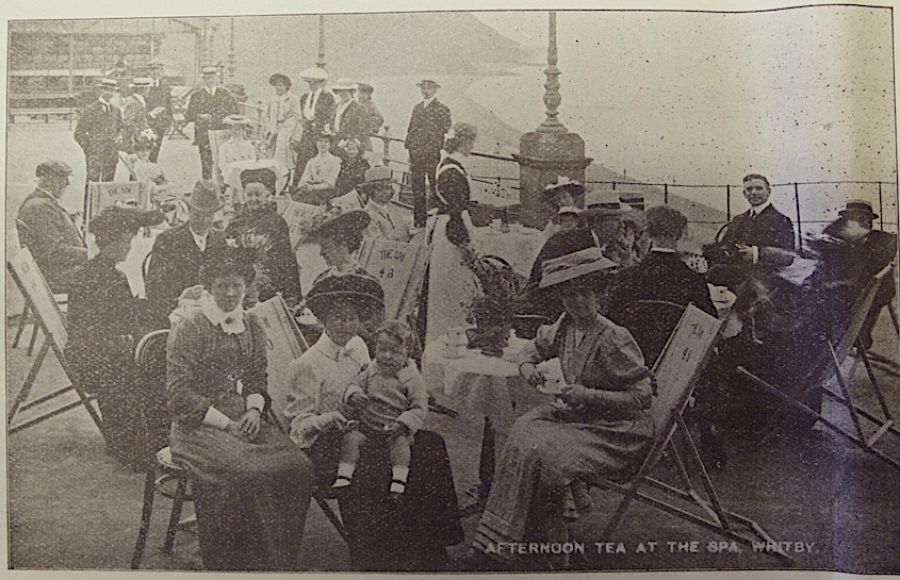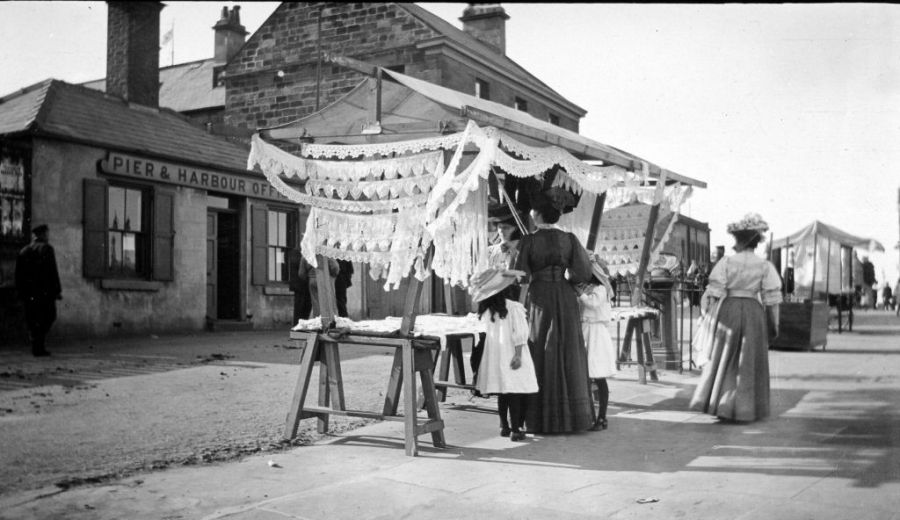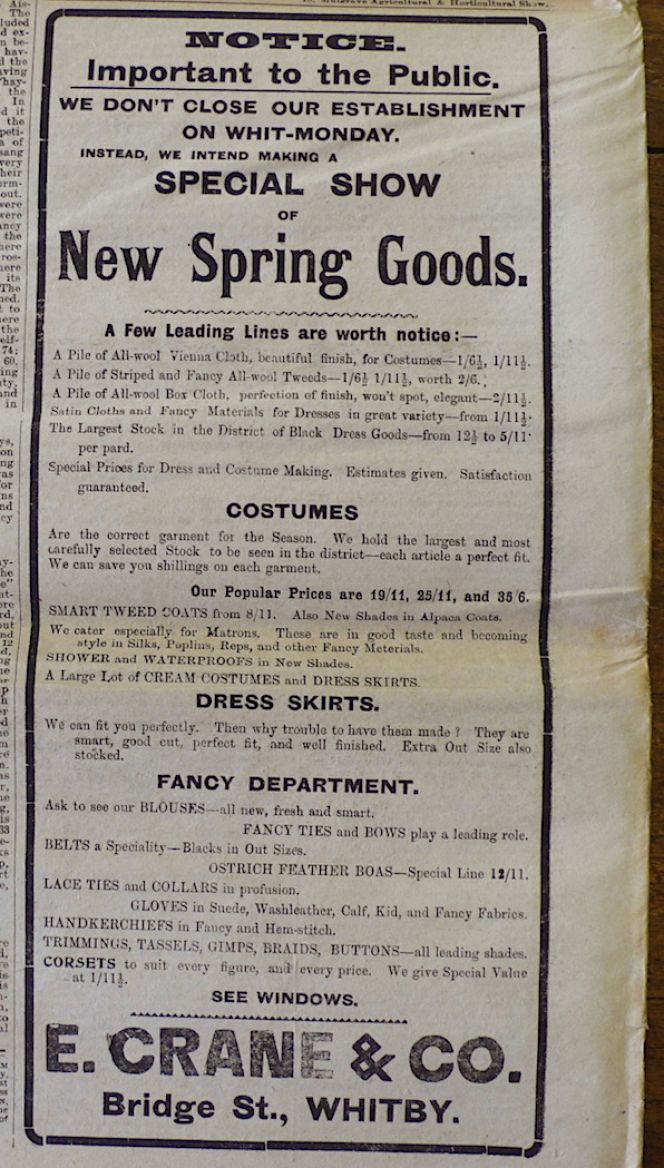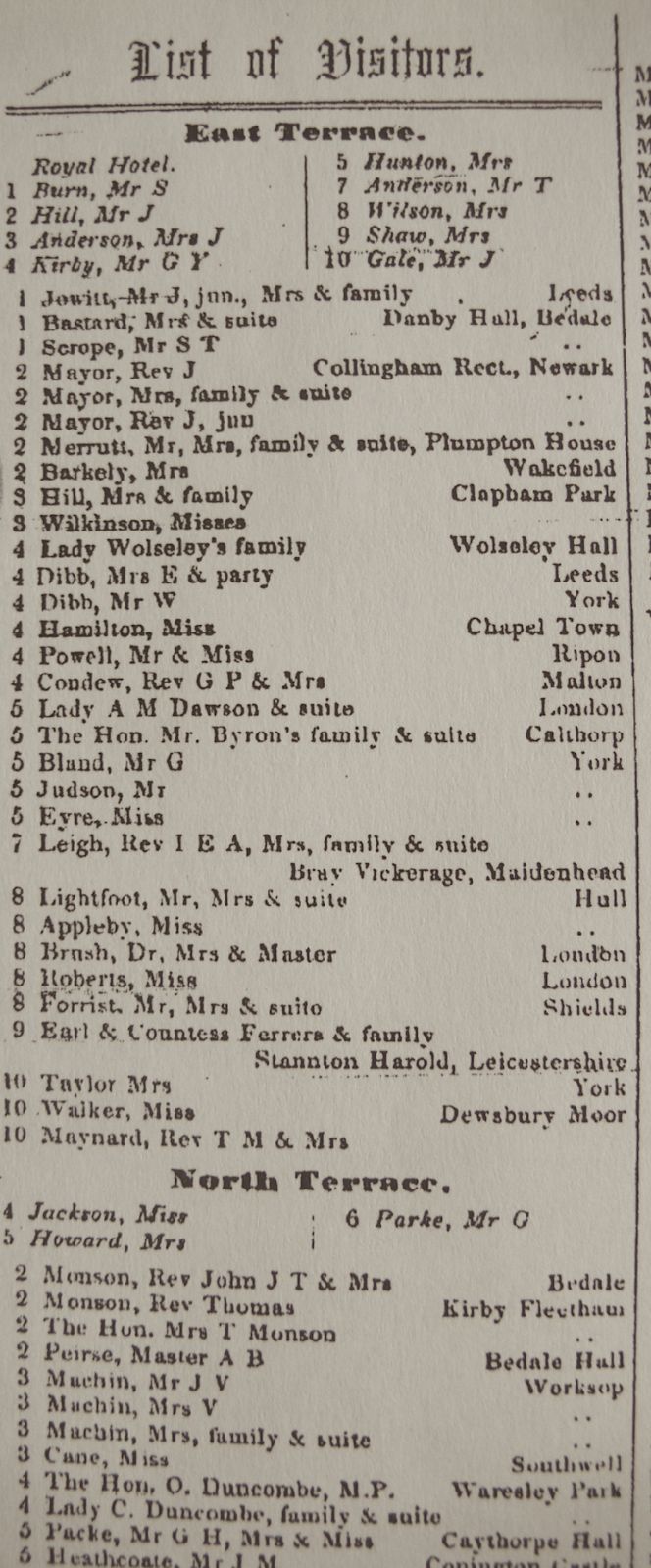ikfoundation.org
Promoting Natural & Cultural History



ESSAYS |
FASHIONS FOR THE SUMMER SEASON
– Advertising 1855-1914
Advertisers, photographers, shop owners and many others took advantage of offering their services to the coastal tourists of Whitby; many stayed for weeks and sometimes months according to the ‘List of Visitors’ featured in the local newspaper. Studies into this subject were presented in The Textile History of Whitby 1700-1914 – based on a multitude of primary sources giving evidence for that most drapers, tailors, dressmakers and milliners were in various degrees dependent on the Summer Season. This period approximately lasted from May to early October, when many traders advertised more frequently and often aimed at visitors as well as local customers willing to buy suitable light garments for leisure time or practical clothing for walking etc. Sometimes referring to their connections with the textile trade in London.
 ‘Afternoon Tea at the Spa, Whitby’ with a view over the sea. Summer visitors featured in a Supplement to the Whitby Gazette on July 20th in 1906. (Whitby Museum, Library & Archive). Photo: Viveka Hansen.
‘Afternoon Tea at the Spa, Whitby’ with a view over the sea. Summer visitors featured in a Supplement to the Whitby Gazette on July 20th in 1906. (Whitby Museum, Library & Archive). Photo: Viveka Hansen.Advertising of ‘Spring and Summer Goods’ was a common feature and this study will give a few examples from ‘List of Visitors’ as well as advertisements and supplements from Whitby Gazette. James N. Clarkson & Son was one of the larger stores that frequently announced its extensive stock; for instance ‘Summer, 1880, All Departments of the House are now well supplied with New Stock, bought direct from the Manufacturers’ and five years later in 1885. ‘We are now showing in all departments – Novelties for the Summer Season’ in the following six departments: ‘Silks, Dresses, Mantles & Jackets, Fancy Department, Millinery, and Dressmaking’.
Another tailor & draper in Whitby who mentioned his experience of the latest fashion was ‘J.V. Andrew, from Marshall & Snelgrove, London, having just returned from the French and English Markets, is now prepared to show all the novelties of the season’ in 1870. Marshall & Snelgrove had been in business since 1848, and in J.V. Andrew’s time had premises in Oxford Street, and it is interesting to note that this well-known London firm had several other branches, including one in Scarborough, which in periods had seasonal openings. In the spring of 1880, Andrew continued to advertise in the same style (‘Selected Personally from the Best London Houses’), and his chief interest was still ladies’ clothes and hats, inexpensive material.
 In this early 20th century photograph a display of different breadths of lace has attracted the attention of a well-dressed lady with two small daughters at her side. It seems that this lace stall operated on this spot during the summer months up to the outbreak of the First World War. (Courtesy of: Whitby Museum/Whitby Lit. & Phil. Photographic Collection, W 4394.)
In this early 20th century photograph a display of different breadths of lace has attracted the attention of a well-dressed lady with two small daughters at her side. It seems that this lace stall operated on this spot during the summer months up to the outbreak of the First World War. (Courtesy of: Whitby Museum/Whitby Lit. & Phil. Photographic Collection, W 4394.) The drapery E. Crane & Co. advertised in great detail about their ‘Special Show of New Spring Goods’ in Whitby Gazette on May 28th, 1909. (Whitby Museum, Library & Archive). Photo: Viveka Hansen.
The drapery E. Crane & Co. advertised in great detail about their ‘Special Show of New Spring Goods’ in Whitby Gazette on May 28th, 1909. (Whitby Museum, Library & Archive). Photo: Viveka Hansen.Some businesses might only be open for half the year and could thus announce seasonal opening and closing dates in the local paper. Edmund Crane’s establishment in Bridge Street changed its name in 1893 to E. Crane & Co was, on the other hand, open all year around and also the only “textile trader” who can be traced through various notices in Whitby Gazette for the whole period of 1855 to 1914 (see image above). They advertised frequently until 1899 and then slowed down for a decade to resume frequent advertising in 1909-1914. For example, it may have concerned fabrics for sewing into clothes; alternatively, if the customer preferred, clothes could be made up by a tailor or dressmaker, or ready-made in the form of ‘Smart Tweed Coats, Waterproof Coats, Cream Costumes, Dress Skirts, Belts, Ostrich Feathers, Lace Ties, Corsets to every figure and every price…’ (spring 1909). In other words, clothes typical of Edwardian ladies’ fashions, together with the popular waterproof garments that had begun to be worn more widely as early as the 1890s. Another recent novelty was ‘Cycling Costumes’, which had featured in Crane’s advertisement for Spring 1897.
 A section of ‘List of Visitors’ from October 10th in 1857, including addresses and accommodations in the hotel/guest house districts of West Whitby. Notice that the illustrated list was printed in October, implying that Whitby was still a popular health-resort/tourist place to visit at that time of year. Through this decades these types of lists were featured in the local newspaper and for example on July 3rd in 1880 – visitors’ names were recorded below Terraces, Streets, Places and Avenues in the extending popular west district of the town. Even in the early 20th century this ‘List of Visitors’ were part of the weekly paper during the “Season”. (Whitby Museum, Library & Archive). Photo: Viveka Hansen.
A section of ‘List of Visitors’ from October 10th in 1857, including addresses and accommodations in the hotel/guest house districts of West Whitby. Notice that the illustrated list was printed in October, implying that Whitby was still a popular health-resort/tourist place to visit at that time of year. Through this decades these types of lists were featured in the local newspaper and for example on July 3rd in 1880 – visitors’ names were recorded below Terraces, Streets, Places and Avenues in the extending popular west district of the town. Even in the early 20th century this ‘List of Visitors’ were part of the weekly paper during the “Season”. (Whitby Museum, Library & Archive). Photo: Viveka Hansen.Sources:
- Hansen, Viveka, The Textile History of Whitby 1700-1914 – A lively coastal town between the North Sea and North York Moors, London & Whitby 2015 (Chapter III).
- Whitby Gazette, 1855-1914 (Whitby Museum, Library & Archive).
- Whitby Museum, Photographic Collection (studies of local photographs).
ESSAYS
The iTEXTILIS is a division of The IK Workshop Society - a global and unique forum for all those interested in Natural & Cultural History from a Textile Perspective.
Open Access essays - under a Creative Commons license and free for everyone to read - by Textile historian Viveka Hansen aiming to combine her current research and printed monographs with previous projects dating back to the late 1980s. Some essays also include unique archive material originally published in other languages, made available for the first time in English, opening up historical studies previously little known outside the north European countries. Together with other branches of her work; considering textile trade, material culture, cloth manufacturing, fashion, natural dyeing and the fascinating world of early travelling naturalists – like the "Linnaean network" – from a Global history perspective.
For regular updates, and to make full use of iTEXTILIS' possibilities, we recommend fellowship by subscribing to our monthly newsletter iMESSENGER.
been copied to your clipboard




– a truly European organisation since 1988
Legal issues | Forget me | and much more...
It is free to use the information/knowledge in The IK Workshop Society so long as you follow a few rules.
 LEARN MORE
LEARN MORE








